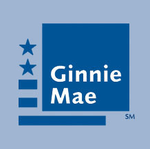Government National Mortgage Association
 | |
| Founded | 1968 |
|---|---|
Area served | United States of America |
Key people | |
Number of employees | 140 |
| Website |
www |
The Government National Mortgage Association (GNMA), or Ginnie Mae, was established in the United States in 1968 to promote home ownership. As a wholly owned government corporation within the Department of Housing and Urban Development (HUD), Ginnie Mae’s mission is to expand affordable housing finance in America by linking domestic and global capital to the nation's housing finance markets, providing market liquidity to federally sponsored mortgage lending programs.
The Ginnie Mae guarantee allows mortgage lenders to obtain a better price for their loans in the capital markets. Lenders then can use the proceeds to make new mortgage loans available to consumers. This also helps to lower financing costs and create opportunities for sustainable, affordable housing for families seeking home ownership.
History
In 1934, during the depths of the Great Depression, Congress responded to the crisis by passing the National Housing Act of 1934, which established the Federal Housing Administration (FHA). One of the principal objectives of the FHA was to increase the flow of capital to the housing markets by insuring private lenders against the risk of mortgage default. FHA also was tasked with chartering and regulating a national mortgage association that would buy and sell FHA-insured mortgages.
In 1938, Congress amended the act to create the Federal National Mortgage Association, more commonly known as "Fannie Mae", to help mortgage lenders gain further access to capital for mortgage loans.
The provisions of the act changed gradually over the years. It was not until 1968, however, in response to a perceived need to further broaden the capital base available for mortgages that the housing finance system began to resemble its current form. As part of the Housing and Urban Development Act of 1968, Congress partitioned Fannie Mae into two entities:
- Fannie Mae, which was still originally restricted to purchasing FHA/VA mortgages (Fannie Mae was permitted to deal in conventional mortgages in 1970), and
- Ginnie Mae, formerly the Government National Mortgage Association, which originally only provided insurance for bonds issued by FHA/VA mortgages in special affordable housing programs.
Today, Ginnie Mae securities are the only mortgage-backed securities that are backed by the "full faith and credit" guaranty of the United States government, although some have argued that Fannie Mae and Freddie Mac securities are de facto or "effective" beneficiaries of this guarantee after the US government rescued them from insolvency in 2008.[2]
Business
Ginnie Mae guarantees the timely payment of principal and interest payments on residential mortgage-backed security (MBS) instruments to institutional investors worldwide. These securities, or “pools” of mortgage loans, are used as collateral for the issuance of securities on Wall Street. MBS instruments are commonly referred to as "pass-through" certificates because the principal and interest of the underlying loans is "passed through" to investors; because of Ginnie Mae's financial backing, these MBS instruments are particularly attractive to investors and, like other Agency MBS instruments, are eligible to be traded in the "to-be-announced," or "TBA" market.[3]
Ginnie Mae guarantees only securities backed by single-family and multifamily loans insured by government agencies, including the FHA, Department of Veterans Affairs, the Department of Housing and Urban Development’s Office of Public and Indian Housing, and the Department of Agriculture’s Rural Development.
Ginnie Mae neither originates nor purchases mortgage loans. It does not purchase, sell, or issue securities. Accordingly, Ginnie Mae does not use derivatives to hedge and it does not carry long-term debt (or related outstanding securities liabilities) on its balance sheet. Instead, private lending institutions approved by Ginnie Mae originate eligible loans, pool them into securities, and issue the Ginnie Mae MBS instruments. These institutions include geographically diverse mortgage companies, commercial banks, and thrifts of all sizes, as well as state housing finance agencies.
Role in the housing recovery
In 1970, Ginnie Mae became the first organization to create and guarantee MBS products and has continued to provide mortgage funds for homebuyers ever since. Even in uncertain times, investors are guaranteed payment of interest and principal, in full and on time. The benefits of this process are passed on to the lenders who can then make more mortgage loans at more affordable rates.
Government-sponsored enterprises and government-owned enterprises
Ginnie Mae is a wholly owned government corporation. Fannie Mae and Freddie Mac, on the other hand, are "government-sponsored enterprises" (GSEs), which are federally chartered corporations, but still privately owned by shareholders. In September 2008 the GSEs were placed under government conservatorship.
Ginnie Mae neither originates nor purchases mortgage loans nor buys, sells or issues securities in the U.S. capital markets. The credit risk on the mortgage collateral underlying its MB securities primarily resides with other insuring government agencies. Rather, Ginnie Mae is the guarantor of MBS issued by government-approved securities issuers who participate in Ginnie Mae’s program.
See also
Companies
References
- 1 2 3 Ginne Mae (April 5, 2017). "Executive Leadership".
- ↑ Kopecki, Dawn. "Fannie, Freddie Have `Effective' Guarantee, FHFA Says (Update1)". October 23, 2008. bloomberg. Retrieved 15 May 2013.
- ↑ Lemke, Lins and Picard, Mortgage-Backed Securities, Chapters 2 and 4 (Thomson West, 2013 ed.).
